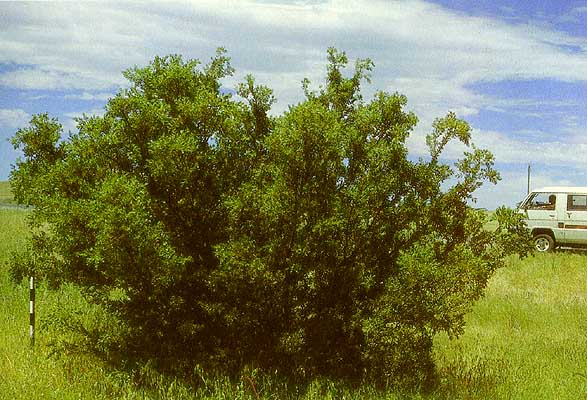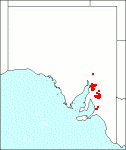Family: Fabaceae
Acacia wattsiana

Citation:
G. Bentham, FI. Aust. 2:374 (1864).
Derivation: wattsiana— probably commemorates Alfred Watts, one of the two members of the Legislative Council elected in 1855, died 1884.
Synonymy: Not Applicable Common name: Watt's wattle, dog wattle
Description:
Dense, bushy, rounded, spreading, glabrous shrubs 1-2 m high; branchlets prominently angled, older branches striate, ribbed, almost terete; bark thin, greyish-brown. Phyllodes narrow-obovate, oblanceolate, 3-6 cm long, 4-10 mm broad, straight or slightly curved, glabrous, light-green, mid-vein slightly eccentric, lateral veins numerous obscure and reticulate, margins prominent and yellowish, apex obtuse and with or without a short mucro; glands small situated on the upper margin below the centre of the phyllode,
Inflorescences axillary glabrous racemes, normally c. half as long as the phyllodes, rarely almost as long as phyllodes, raceme axis slender, glabrous and normally with 5-8 heads; flower-heads globular, yellow 15-20-flowered; peduncles slender, glabrous, 3-5 mm long; flowers 5-merous.
Legumes linear, 6-12 cm long, 6-7 mm broad, coriaceous, flat but raised over seeds, narrowed at both ends, short-stipitate; margins thickened and vein-like, slightly contracted between seeds. Seeds longitudinal in legume; funicle long, encircling seed in a double fold and expanded into a broad whitish aril.
|
|
Distribution:
|
Endemic to South Australia with a rather restricted distribution in the Northern Lofty region. The most southern occurrence is near Clare associated with woodland to open forest or tussock grassland vegetation. Soils; mainly hard alkaline, red duplex. Rainfall 500-600 mm.
S.Aust.: FR, NL, MU, SL.
|
Conservation status:
Lang & Kraehenbuehl (1987) consider this species to be Rare but conserved.
Flowering time: October — December.
|

SA Distribution Map based
on current data relating to
specimens held in the
State Herbarium of South Australia
|
Biology:
No text
Related taxa:
Acacia hakeoides (sp. 51) has only slightly angular branches, more flowers per head and funicle short not encircling seed. Acacia brachybotrya (sp. 12) has shorter more or less silky hairy phyllodes. A. quornensis (sp. 41) has lanceolate phyllodes with fewer flowers per head.
Taxonomic notes:
A variant of A. wattsiana occurs near Nectar Brook that has a more open habit, broader phyllodes and larger flower heads but to date it has not been given a name.
Cultivation:
Grows well in the southern districts with a medium rainfall. A good compact hardy shrub, suitable as an ornamental for roadside plantings, and low shelter belt plantings. Fast growth rate.
Author:
Not yet available
Source:

|

